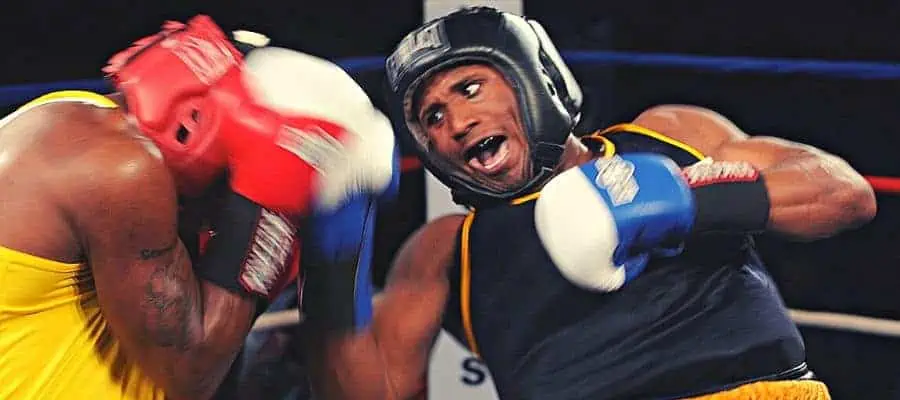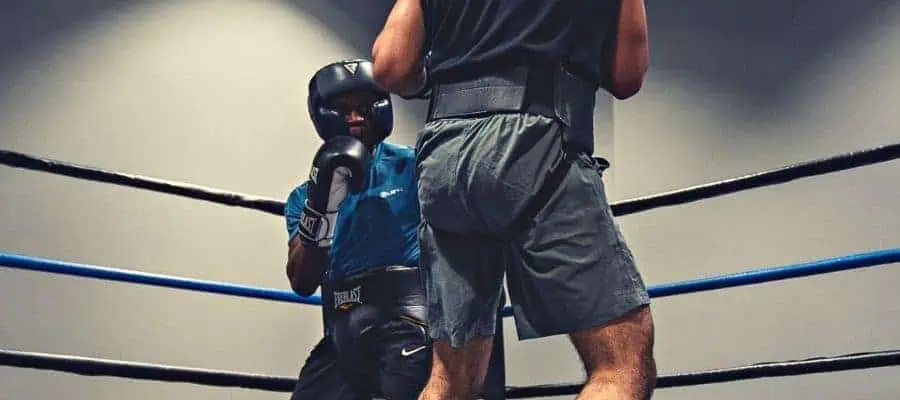Boxing, as we all know, is a brutal sport. Aside from most martial arts or striking-based sports, it is the most daunting and physical of the lot. On average, professional boxers receive hundreds to thousands of punches to the head. It varies, of course, but when you fight professionally, the number only increases.
So why do pro boxers rarely fight? There are many risks in professional boxing. These can be risks of getting injured before the fight due to intensive training or regaining health after a hard and traumatic fight. Besides, many fighters treasure their achievements and do not want to be defeated in their career.
In professional boxing, the body is the weapon of choice. We know this because of the number of workouts, drills, sparring sessions, and early-morning jogs. There are many other reasons why professional fighters – especially those at the top level – fight so frequently.
Most Common Reasons Why Pro Boxers Fight Rarely

But what also makes a top fighter’s routine is that they get punched frequently. Punches to the face and body can develop early symptoms of diseases like MLS or Parkinson’s, as we’ve seen with boxing legend Muhammad Ali.
Injuries
After a fight, the two fighters will have broken ribs, or if the fight becomes even more severe as it progresses, there would be the possibility of urinating blood. That itself is never a good sign so preserving the body from unnecessary damage is crucial to a boxer’s well-being. It goes without saying that our health is our wealth, which resonates with most athletes fighting at a professional level.
They protect themselves at all times, but occasionally, a few punches can slip through the guard and hit the intended target. It’s a little different in real life. Many don’t realize the number of hours fighters put into their training regime. Hip movements, leg movements, postures, hand speed, and flexibility make a top fighter’s routine.
As seen in many fights, a blow to the liver can bring a fighter to his/her knees. The pain is instant and takes your breath away. A few broken ribs aren’t a positive outcome, along with a ruptured spleen or injury to the liver.
While some can find a resolution in the meantime, many haven’t been able to survive the round. Liver shots hurt very badly, but they don’t kill. That is not something an elite fighter would like to experience regularly. It could damage their image and brand if they were to become predictable and hittable. They are more prone to preserve their record or belt as fighting too many times a year can wear out the body.
Statistically, 90% of boxers experience a concussion at some point in their careers, so to put it into perspective, accumulating damage can lead to long-term health issues.
Long Term Damage
As mentioned, the risk of injury is greater at the championship level because of the increased competition skill. The primary concern for boxers is brain trauma. From head trauma after-effects to financial concerns, many fighters choose to maintain their image and boxing record.
This type of injury doesn’t usually heal and the chance of fighting each time increases the possibility. This is another reason boxers may take fewer fights as they progress in their careers. What’s more, every fight at the championship level will be twelve rounds, making the toll on the brain a very high one with each fight (Remember: there are 3 minutes per round), especially as the opposition becomes tougher as one climbs the ladder.
That’s why so many high-level boxers, such as Floyd Mayweather or Tyson Fury, fight literally once a year. There are many risks involved in frequent bouts across the board.
Fear of Losing
Since the completion is rife and more fighters are at each other’s throats, playing it safe is something professional boxers do. And with many fighters having no losses on their records, they tend to take up fights where they know it is secure. For example, a Joshua vs. Fury fight could have earned both multimillions.
As boxers gain more popularity as their stock soars, and with more and more money being made, the most popular fighters have all the power in the world to limit their fights to a few per year. A Joshua vs. Wilder could also have generated massive revenue. Unfortunately, neither fight was made to this day because both parties involved saw the risks associated with it.
This is mainly because they can earn more, and the curiosity and excitement in between fights by stretching them out make these newly renowned ‘money fights’ more exciting.
Money
Once a boxer starts to generate popularity and fights at main events on Pay View, money can also be a factor. Money is also a factor, as you can imagine. Upon winning a major title, it is favorable for the titleholder to prolong their time between fights.
This is because prolonging a title defense means there’s way more free time to promote and hype up a fight. There is also more time for the fighter to prepare mentally and what’s inevitable is a better payday due to the increased interest. There is also the question of risk.
Why should one fight more than twice a year if he or she can make the same amount of money?
As unfortunate as it may sound, making enough money can lead to fighters lacking motivation and the drive to even train. Marvin Hagler once said, ‘It’s tough to get out of bed to do roadwork at 5 am when you’re sleeping in silk pajamas.
Why Do Boxers Fight Irregularly?

Around the golden days, there were only 2 bodies in boxing, now known as the World Boxing Association [WBA and the World Boxing Council [WBC]). During this time, fighters had only one or two titles but rather a lot of challenges. As the chance of winning a championship was nearly scarce, and the number of mandatories was too much, each fighter had to most likely fight often.
Unlike the 60s and 70s, when boxing was seen as a way to make money, only boxers that fought consistently and performed at the highest possible level earned good purses. The financial conditions nowadays, compared to the old days, were much better. Many boxers today come from middle-class or low-middle-income families that can provide.
Lack of hunger and passion is also a factor due to making decent amounts of money. The result is that they have a different drive for success than they once had and are more than happy with lucrative paydays of 2 to 3 fights per year.
Do Boxers “Duck” Other Fighters?

As discussed earlier, many of the reasons why a boxer might avoid a fight depend on the type of scenario present. No boxer wants to have a reputation for “ducking” other fighters. It’s probably one of the lowest insults one can give, yet it is pretty frequent in professional boxing.
Most often, it’s because he/she wants to protect his/her belt and record or maintain the chance of landing a more significant fight later on in their career that seems to be the best move to take. Still, those aren’t the only reasons why.
The majority of high-level boxers are supremely talented, and most of them would be at the top of their respective divisions. However, time and time again, we have seen that avoiding certain fights that fans would die for is pretty commonplace.
How Frequently Might A Boxer Compete?

It may be confusing and daunting to figure out why some boxers only fight a couple of times yearly while other fighters fight every couple of months. As you can probably tell by now, many professional boxers tend to avoid or ‘duck’ fights, as it is known. The higher one’s stock is, the more opportunities they have in terms of leverage on how they dictate their fights.
This is normal for upcoming boxers as they attempt to gain recognition and develop a decent record. It is common for these prospects to have fights lined up almost every month. To give you an idea, Floyd Mayweather, is one of the best defensive fighters of his generation. He has only fought twenty-nine times from 1999 to 2015, which is phenomenal, whatever way you want to look at it.
Frequent fights make less sense the closer a boxer is to the superstar level. Moreover, the risk of injury is more significant at this level of boxing due to the increased skill of the competition, making every fight negotiation notoriously tricky.
Maybe many people haven’t thought about how often a pro-fighter should defend their belts. It’s a good question. We have seen martial arts promotions such as the UFC allowing their fighters to go without defending their belts for long periods.
It’s a bit stricter in professional boxing, though. For example, a WBC (World Boxing Council) champion should realistically aim to defend the title in mandatory or voluntary defenses at least 3 times per year. Unless there’s an exception or extension. Someone that does not defend his title within those periods will have to forfeit their title unless the WBC dictates otherwise.
How Much Do Boxers Get Paid?

Money is one of the primary reasons that boxers ascend to the level of professional boxing. Many factors go into a professional boxer’s annual salary, such as how regularly they compete, the various endorsement deals, and fighters’ soaring popularity. It would be worth knowing how much income top fighters actually make.
Sponsorship And Social Media
Social media evidently plays a huge role nowadays. It’s much easier to post a photo on Instagram supporting a specific brand than to film a brand-new commercial. It’s a huge money-making method that supports the fighters, especially top boxers with large social media followings.
As we all know, superstar boxers like Muhammad Ali or Floyd Mayweather generated millions from fights and sponsorships alone. When you think about it, it’s a lot of money to be made.
Amateur Carrier
Take into consideration that there are levels to elite boxing. Boxers would get paid less than $200 dollars per fight in the amateur circuit. On the downside, there are no laws or regulations for the minimum wage of a boxer. It’s even more complicated as the prize money per fight could be significantly lower. Fighters that are starting up earn less than $1000 per fight.
Pro Carrier
On average, a professional fighter earns between $20,000 – $36,000 in the United States. It’s clearly a big gap from the top fighters. An ultimate fighter generates millions and millions, up to the point where many critics have called boxing the ‘most corrupt sport’ in the world. And it is due to unsavory dealings and the tainted image of boxing itself (judges, bribery).
But also, it doesn’t matter how good a fighter is. We need to understand that boxing is ultimately a business. If nobody is interested in your fights, then you won’t be able to market yourself the same way top fighters do. It is essential, considering most professional boxers fight anywhere from twice a year up to seven times in one year: that is a long time between fights.
Sponsorship And Social Media
You’ve probably seen the many logos and icons involved in boxing. This is because the spotlight on boxing all around the globe is huge. Thousands of brands love to bet their hard-earned cash by investing in it, which is excellent for promoters and boxers. Sponsorships are one of the best ways for professional boxers to earn money outside competing. Also, Boxers typically make split the “fight purse” for fighting.
In addition, social media plays a huge role nowadays. It’s much easier to post a photo on Instagram supporting a specific brand than to film a brand-new commercial. It’s a huge money-making method that supports the fighters, especially top boxers with large social media followings.
As we all know, superstar boxers like Floyd Mayweather generated millions from fights and sponsorships alone. When you think about it, it’s a lot of money to be made.
The Time Between Fights In Other Martial Arts

We’ve seen the time between fights that boxers take. How often can fighters in other martial arts fight? It can be difficult to say. We are left wondering how long it will be until we see our favorite fighters back in the ring.
MMA
How long do UFC fighters have to wait between fights? The amount of time depends. UFC fighters must wait, depending on the damage professional fighters intake when competing.
MMA is a hazardous sport, after all. Fighters are given time to heal between fights. Failing to treat injuries can be crucial to any fighter’s career. A fighter needs to heal properly before fighting at the highest level. Professional training camps can last between 8-12 months.
A UFC fighter is legally allowed to fight every week (provided they have no injuries). And similar to boxing, it’s unlikely that a top fighter will compete every few months if he or she had the option otherwise.
These martial arts are prevalent and bring millions of dollars to the promoters, their fighters, and the spectators who place bets. So it’s understandable why promoters and managers encourage their superstar boxers to fight only when it makes sense for all parties involved.
Muay Thai
In Muay Thai, for example, an average timeline for a fighter to not compete in would range from 21 days before their next bout. This is usually after five-round fights. The winner in a typical Muay Thai bout will then be suspended for a week or 7 days. This is common, especially in lesser-known circuits and promotions.
It also depends on past bouts. If nothing significant happens during the fight, the waiting time is less. If they were knocked out, then the waiting period is definitely longer. The fighter must wait a minimum of 45 days to re-enter the ring.
And if they include a face cut, the minimum medical suspension is 60 days. If a fighter is choked unconscious or experiences a technical KO, they can’t compete for 30 days.
Conclusion
Every situation is different and may have different outcomes. Boxers are also businessmen at the end of the day. Marketing in the era of digital media is what generates the most. Fighting fewer intrigues a wider audience. Fighting also protects the body and head from unnecessary trauma. Ultimately, a wide variety of these choices impacts a fighter’s final decision.
Recent Posts
What is Manachai's Fighting Style? Unveiling Muay Thai Mastery
Manachai, a celebrated figure in the Muay Thai world, has captivated audiences with his exemplary martial prowess. Hailing from the heartlands of Thailand, his name is synonymous with the art of...
What Was Chamuekpet Hapalang's Fighting Style? Unveiling Techniques
Chamuekpet Hapalang was a renowned figure in the world of Muay Thai (record 200-48-2), embodying a fusion of Muay Bouk and Muay Khao styles. Originating from Thailand, the art of Muay Thai is known...
